South Carolina is home to a diverse array of owl species, with eight distinct types gracing its varied landscapes. These nocturnal hunters, known for their enigmatic charm, contribute to the state’s rich biodiversity.
Each species plays a unique role in the local ecosystem, from the iconic Eastern Screech Owl to the majestic Great Horned Owl. The presence of these owls signifies the health and balance of South Carolina’s natural habitats.
Exploring the different owl species within the state allows one to delve into their fascinating behaviors, habitats, and roles as apex predators.
As guardians of the night, South Carolina’s owls captivate and contribute to the intricate tapestry of the state’s wildlife, making them essential subjects for conservation and admiration.
8 Owls in South Carolina
Discover the magic of South Carolina’s nocturnal realm as we unveil the presence of eight distinct owl species.
These avian residents enrich the state’s diverse ecosystems and nightscapes, from the elusive Eastern Screech Owl to the formidable Great Horned Owl.
1. Barn Owl
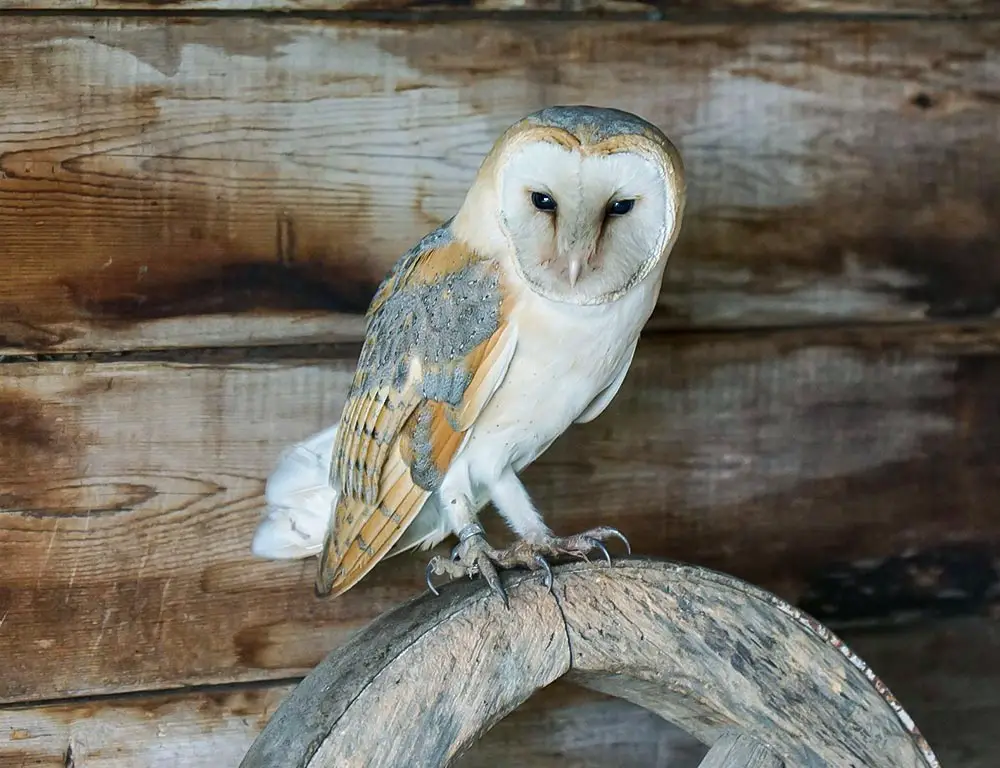
- Scientific Name: Tyto alba
- Category: Bird of Prey (Owl)
- Population: Population size varies; considered common
- Life Span: 1-2 years in the wild (varies due to predation and accidents)
- Size: 12-16 inches in length
- Weight: Approximately 14-24 ounces
- Food: Mainly small mammals (mice, voles, rats), occasionally birds
- Wingspan: 3.3 to 3.7 feet
- Status: Least Concern (population stable)
The Barn Owl’s distinctive heart-shaped face and pale plumage are common in South Carolina. These nocturnal hunters thrive in diverse habitats, including farmlands, grasslands, and marshes.
Barn Owls are exceptional rodent controllers, relying primarily on their keen sense of hearing to locate prey. Their silent flight and specialized facial features contribute to efficient hunting in low-light conditions.
Barn Owls typically nest in cavities, abandoned buildings, or specially designed owl boxes. Despite their widespread distribution, their populations can be influenced by environmental changes and the availability of suitable nesting sites.
Conservation efforts often focus on preserving open landscapes and providing nesting opportunities to maintain the presence of these beneficial birds in South Carolina’s ecosystems.
2. Barred Owl
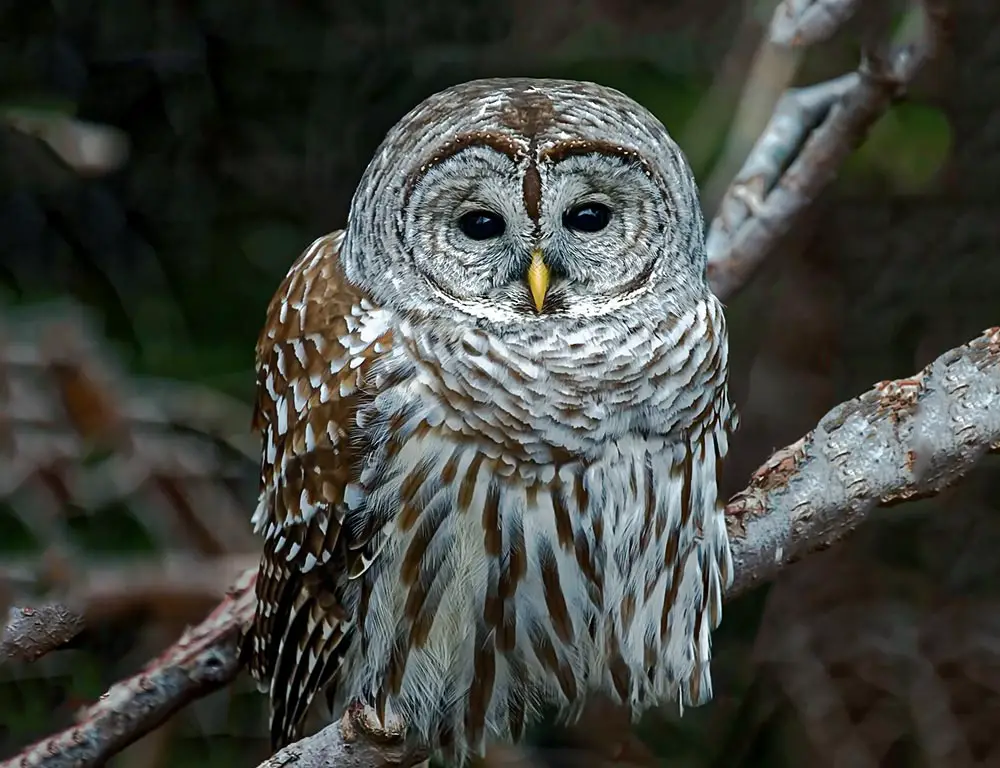
- Scientific Name: Strix varia
- Category: Bird of Prey (Owl)
- Population: Common and stable
- Life Span: Up to 10 years in the wild
- Size: 16-25 inches in length
- Weight: Approximately 1.4-2.3 pounds
- Food: Mainly small mammals, birds, amphibians, and invertebrates
- Wingspan: 3.3 to 4 feet
- Status: Least Concern (population stable)
The Barred Owl, recognized by its distinctive “who-cooks-for-you” hooting call, is a charismatic and adaptable owl species found in South Carolina’s forests.
These owls exhibit a diverse diet, preying on small mammals, birds, amphibians, and even invertebrates. Their ability to adapt to various woodland habitats, from dense forests to suburban areas, contributes to their widespread distribution.
Barred Owls are known for their relatively large size and dark eyes, and they are highly skilled hunters, using their keen vision and silent flight to capture prey.
They often nest in tree cavities, and their populations remain stable due to their ability to thrive in various environments.
Barred Owls are vital in controlling rodent populations and maintaining the ecological balance of South Carolina’s woodlands.
3. Great Horned Owl
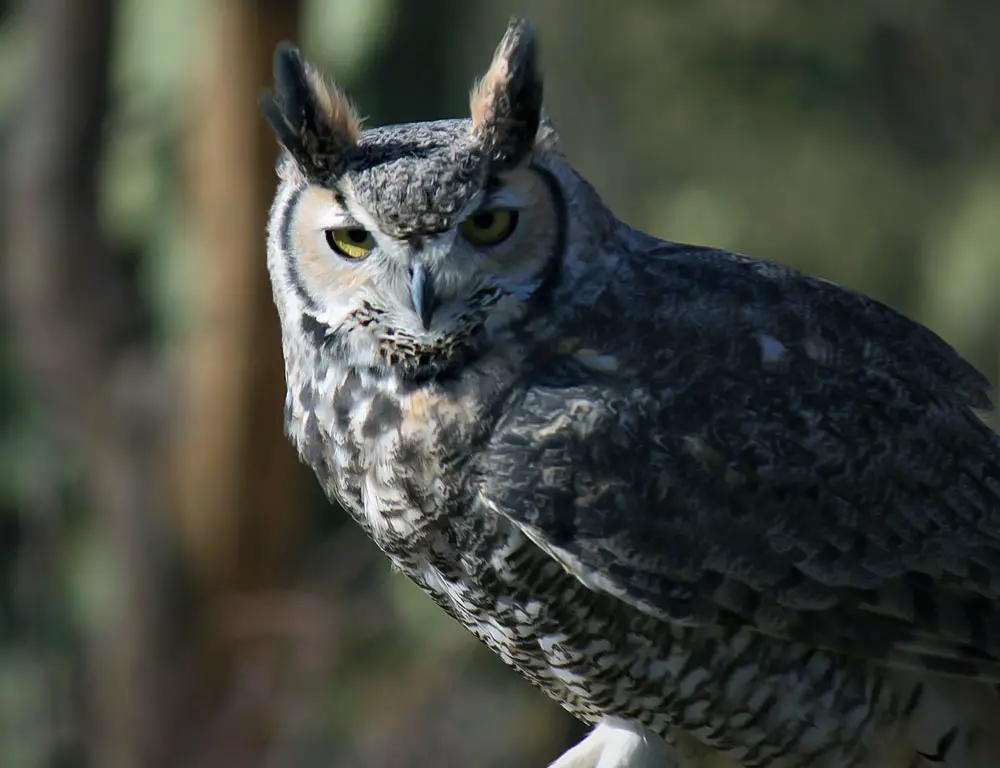
- Scientific Name: Bubo virginianus
- Category: Bird of Prey (Owl)
- Population: Widespread and abundant
- Life Span: Up to 15-20 years in the wild
- Size: 18-25 inches in length
- Weight: Approximately 2-5.5 pounds
- Food: Diverse diet including mammals, birds, and reptiles
- Wingspan: 3.3 to 4.8 feet
- Status: Least Concern (population stable)
The Great Horned Owl, with its imposing size and distinctive “horns” or ear tufts, is a powerful and adaptable predator found in various habitats throughout South Carolina.
As a highly skilled nocturnal hunter, it preys on various animals, including mammals like rabbits, birds, and reptiles. Their exceptional night vision, acute hearing, and silent flight make them formidable hunters.
Great Horned Owls often occupy abandoned nests of other birds and tree cavities or even build nests on ledges. They are known for their adaptability and resilience, successfully coexisting with humans in urban and suburban areas.
These owls are crucial in controlling rodent populations and maintaining a healthy ecosystem. Conservation efforts often focus on preserving their habitats and ensuring the availability of suitable nesting sites.
4. Eastern Screech Owl
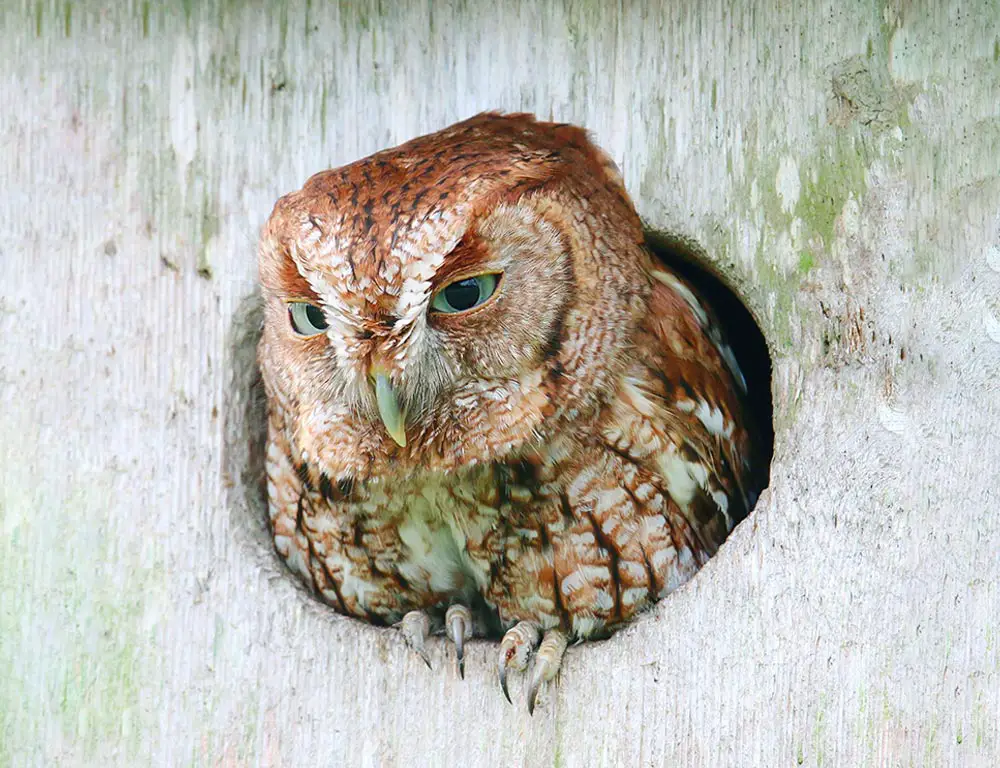
- Scientific Name: Megascops asio
- Category: Bird of Prey (Owl)
- Population: Stable, common
- Life Span: Up to 10 years in the wild
- Size: 6-10 inches in length
- Weight: Approximately 4-8 ounces
- Food: Mainly small mammals, birds, insects, and amphibians
- Wingspan: 1.5 to 2 feet
- Status: Least Concern (population stable)
The Eastern Screech Owl, with its camouflaged plumage and distinctive trilling calls, is a compact and adaptable owl species found in South Carolina’s woodlands and suburban areas.
Despite their small size, they are effective hunters, preying on small mammals, birds, insects, and amphibians. These owls are masters of camouflage, often blending seamlessly with tree bark.
Eastern Screech Owls nest in tree cavities, relying on natural tree holes or nest boxes provided by conservation efforts. Their populations remain stable thanks to their ability to thrive in various environments.
Conservation initiatives often involve creating and maintaining suitable nesting sites and raising awareness about the importance of preserving their habitats for the overall health of South Carolina’s ecosystems.
5. Northern Saw-whet Owl
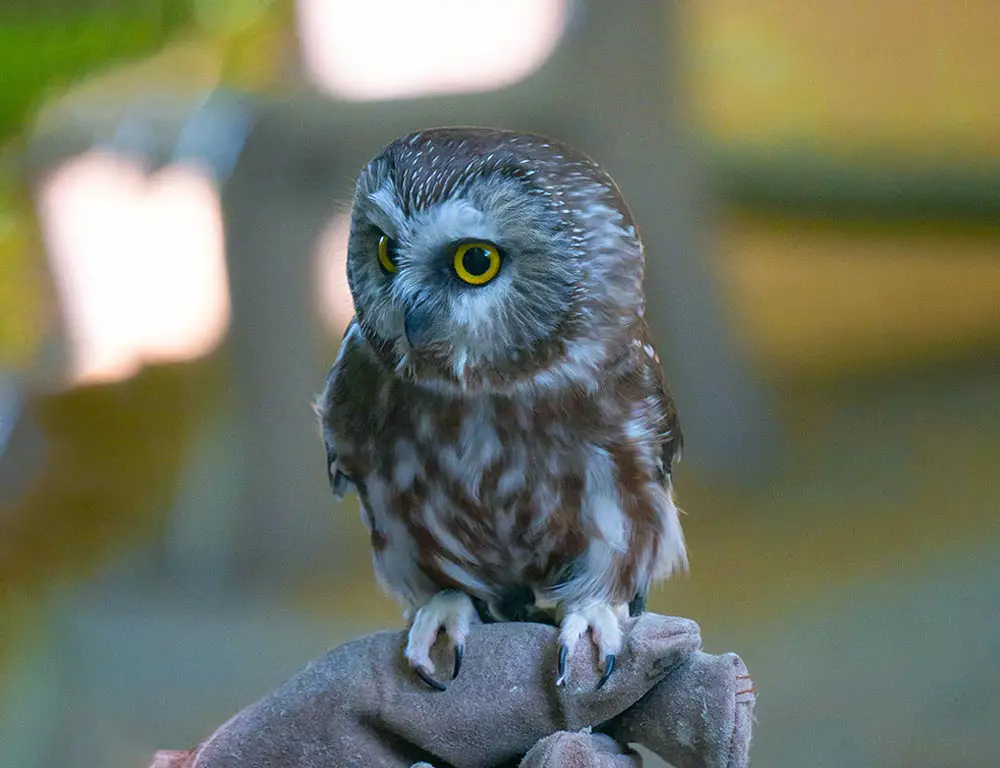
- Scientific Name: Aegolius acadicus
- Category: Bird of Prey (Owl)
- Population: Population size not precisely estimated but considered widespread
- Life Span: Up to 7 years in the wild
- Size: 7-8 inches in length
- Weight: Approximately 2.5-5 ounces
- Food: Mainly small mammals, birds, and insects
- Wingspan: 1.5 to 1.7 feet
- Status: Least Concern (population stable)
The Northern Saw-whet Owl, named for its distinctive sawing or whetting call, is a small and secretive owl species found in coniferous and mixed forests in South Carolina.
Despite their relatively small size, they are skilled hunters, preying on small mammals, birds, and insects. Their plumage provides excellent camouflage in dense foliage.
Northern Saw-whet Owls nest in tree cavities and their populations are considered stable. Due to their elusive nature and nocturnal habits, studying and monitoring these owls can be challenging.
Conservation efforts focus on maintaining suitable forested habitats and preserving the ecological balance necessary for their survival in South Carolina’s diverse woodlands.
6. Short-eared Owl
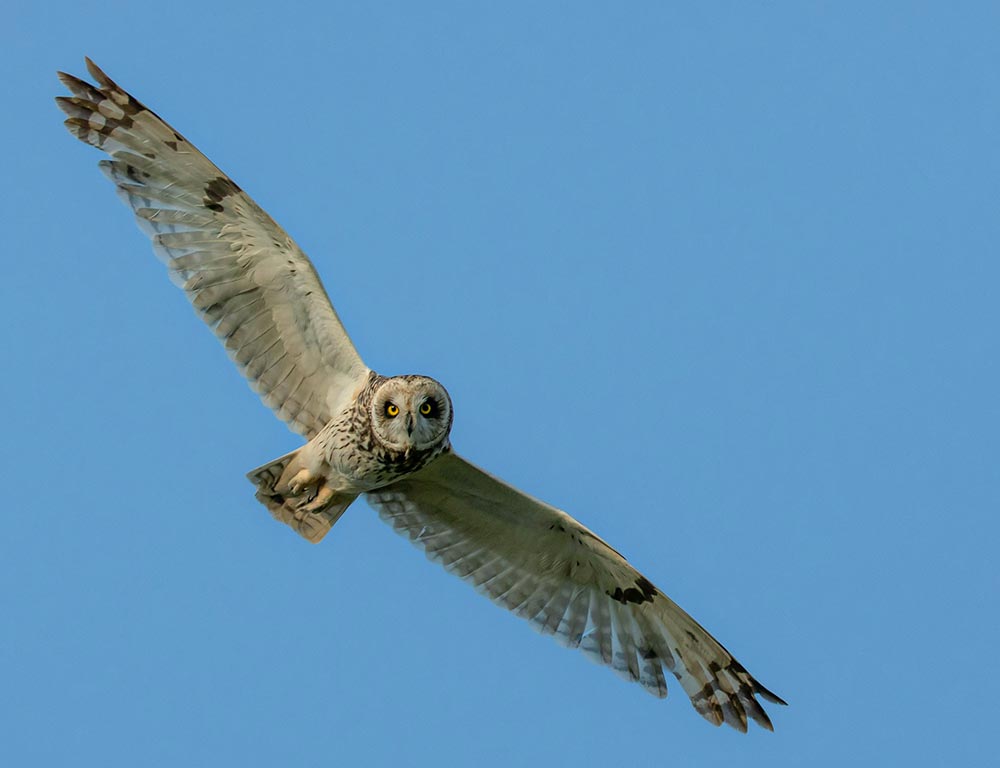
- Scientific Name: Asio flammeus
- Category: Bird of Prey (Owl)
- Population: Variable, with fluctuations tied to rodent prey availability
- Life Span: Up to 10 years in the wild
- Size: 13-17 inches in length
- Weight: Approximately 7.5-17.5 ounces
- Food: Primarily small mammals, supplemented by birds
- Wingspan: 2.9 to 3.3 feet
- Status: Least Concern (population can experience declines during prey scarcity)
The Short-eared Owl, recognized by its distinctive facial disk and short ear tufts, is a ground-nesting species found in South Carolina’s grasslands, marshes, and open fields.
As a crepuscular hunter, it is active during dawn and dusk, preying on small mammals such as voles and mice.
With a characteristic moth-like flight, Short-eared Owls cover large areas in search of prey. Their populations can fluctuate based on rodent availability, making them an indicator species for ecosystem health.
Conservation efforts often involve preserving open habitats, managing grassland ecosystems, and mitigating disturbances to support these captivating owls.
7. Long-eared Owl
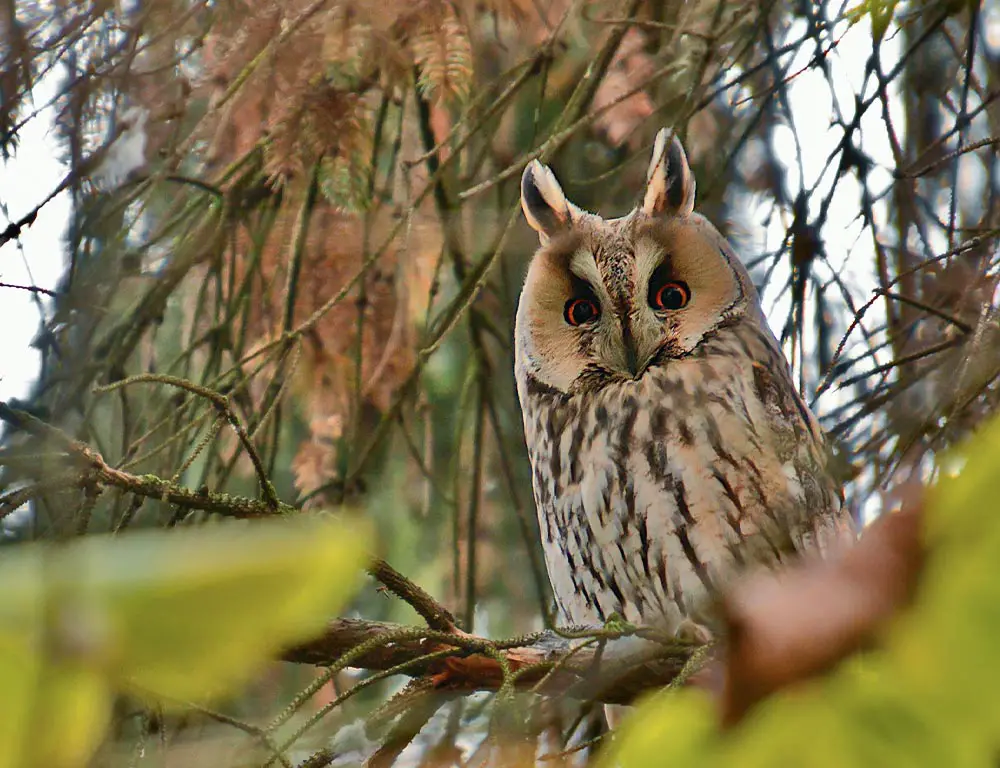
- Scientific Name: Asio otus
- Category: Bird of Prey (Owl)
- Population: Population size varies; considered stable
- Life Span: Up to 10 years in the wild
- Size: 13-16 inches in length
- Weight: Approximately 7-16 ounces
- Food: Mainly small mammals and birds
- Wingspan: 3.3 to 3.6 feet
- Status: Least Concern (population stable)
The Long-eared Owl, characterized by its long ear tufts and mottled plumage, is a woodland species occasionally found in South Carolina’s forests.
These secretive owls roost in dense vegetation or trees during the day, becoming active at night. Their diet consists primarily of small mammals and birds, and they use their keen hearing to locate prey.
Long-eared Owls are known for their cryptic plumage, providing effective camouflage against tree bark. Preserving suitable woodland habitats and minimizing disturbances during the breeding season are crucial for their conservation.
Despite their discreet nature, Long-eared Owls contribute to the ecological balance by helping control rodent populations in South Carolina’s woodlands.
8. Burrowing Owl
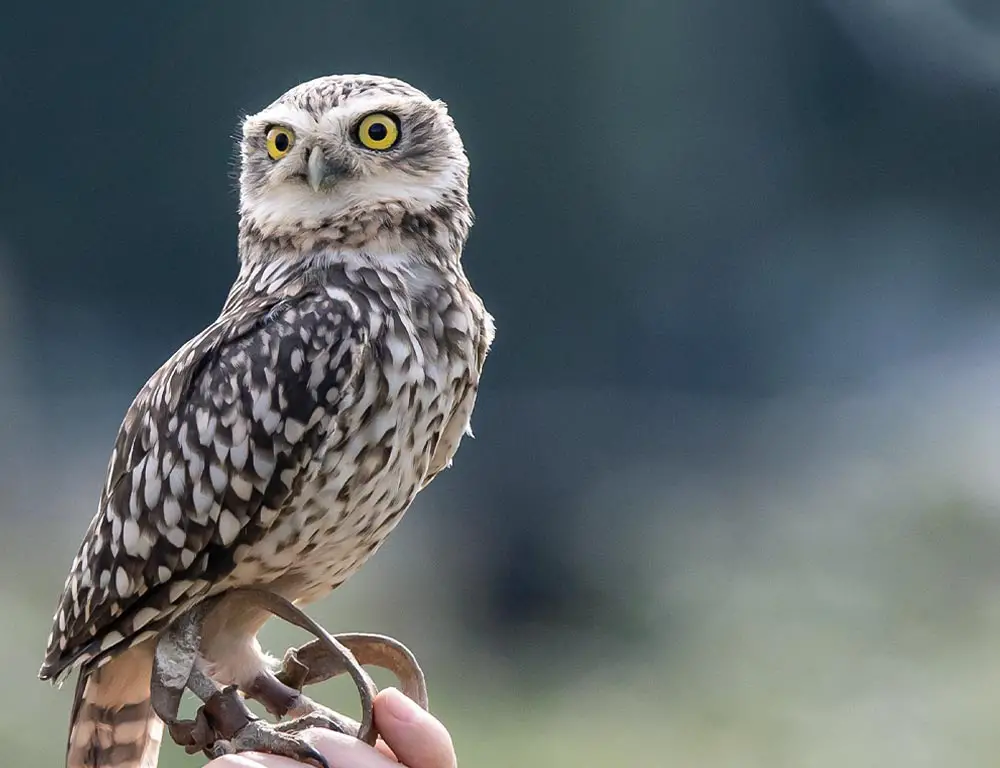
- Scientific Name: Athene cunicularia
- Category: Bird of Prey (Owl)
- Population: Declining in some areas due to habitat loss
- Life Span: Up to 9 years in the wild
- Size: 7.5-10 inches in length
- Weight: Approximately 5-8 ounces
- Food: Mainly insects, supplemented by small mammals and birds
- Wingspan: 21-24 inches
- Status: Least Concern (population decreasing in some regions)
With its unique preference for nesting in abandoned burrows rather than trees, the Burrowing Owl is a distinctive owl species found in open habitats like grasslands and prairies in South Carolina.
Despite being among the smallest owl species, Burrowing Owls are active during both day and night, exhibiting a ground-dwelling lifestyle.
They feed primarily on insects, displaying a keen ability to capture prey in flight. Some populations’ decline is attributed to habitat loss and the scarcity of suitable burrowing sites.
Conservation initiatives focus on preserving open landscapes, managing prairie ecosystems, and providing artificial burrows to sustain and enhance Burrowing Owl populations in South Carolina.
Ecological Significance of Owls in South Carolina
Owls play a significant ecological role in South Carolina, as they do in many ecosystems worldwide. Here are some ecological contributions and significance of owls in South Carolina:
Natural Pest Control
Owls are formidable predators of rodents and small mammals. They help control populations of species like mice, rats, voles, and rabbits.
By keeping these populations in check, owls maintain a balance in the ecosystem and prevent overgrazing or crop damage.
Biodiversity Maintenance
Owls are part of the intricate food web in South Carolina. As predators, they influence the distribution and abundance of their prey species, which can have cascading effects on other organisms within the ecosystem.
This helps maintain biodiversity and a healthy ecosystem.
Nighttime Predator Control
Owls are nocturnal hunters, and their presence helps control populations of nocturnal prey species, such as insects, spiders, and small mammals, that are active at night.
This contributes to the overall regulation of various animal populations.
Indicators of Ecosystem Health
The presence of owls can serve as an indicator of ecosystem health. Healthy owl populations suggest a balanced and functioning ecosystem with sufficient prey availability and suitable habitat conditions.
Seed Dispersal
Some owl species, like the Eastern Screech Owl, contribute to seed dispersal. They may consume fruits and then excrete seeds in different locations, aiding in the regeneration and dispersal of plant species.
Habitat Maintenance
Owls often require large territories for hunting and nesting. Protecting the habitats that support owl populations helps maintain healthy ecosystems.
Conservation efforts to preserve suitable habitats for owls indirectly benefit many other species.
Education and Awareness
Owls are charismatic and captivating birds, making them excellent wildlife education and awareness ambassadors.
Their unique behaviors, adaptations, and roles in the ecosystem can be used to engage the public in conservation efforts and promote a broader understanding of South Carolina’s natural heritage.
Conservation measures that protect owl habitats regulate pesticide use and promote sustainable land management practices, contributing to the continued ecological significance of owls in South Carolina.
Like many other wildlife species, owls are integral components of the state’s natural environment, and their well-being is interconnected with the ecosystem’s overall health.
Wrapping Up
Our exploration of the eight woodpecker species in Missouri reveals these charismatic birds not only bring rhythmic melodies to the state’s woodlands but also serve as ecological architects.
Each species contributes uniquely to Missouri’s ecosystems, from the bold Pileated Woodpecker to the intricate Northern Flicker.
Their role in insect control and habitat modification underscores their importance in maintaining a balanced and healthy environment.
As we marvel at their distinctive characteristics and behaviors, let us appreciate the intricate role woodpeckers play in shaping Missouri’s natural tapestry and enhancing the overall biodiversity of the region.